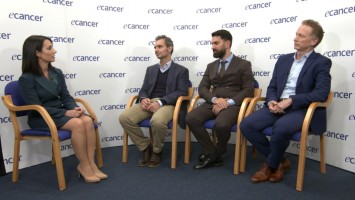We presented the results of the dose escalation part of a phase I trial analysing ceritinib plus nivolumab in patients with ALK positive non-small cell lung cancer. In this dose escalation part we have included 36 patients with ALK positive tumours and we have treated these patients with nivolumab at the standard dose, 3mg/kg every two weeks, and also we analysed two different doses of ceritinib: 450mg with a low fat meal and 300mg again with a low fat meal. Here in the conference we have presented the results of this dose escalation. Overall the 36 patients, the clinical characteristics are the usual as those in patients with ALK positive tumours, median age 54. 15 patients had brain metastases at study entry, all patients had adenocarcinoma histology, 57% never smokers. Also in this study more than 50% of the patients were previously treated with an ALK inhibitor.
What we have seen is that with this combination we observe an unexpected high rate of rash. So 64% of the patients in the study had rash; the rash associated with ceritinib is present only in 15% of the cases, 12% of the patients treated with nivolumab in monotherapy. Apart from rash we observed some hepatotoxicity increase in ALT, in AST, in amylases. At cut-off 15 patients were still on treatment, however from these 15 patients only 8 were still receiving the combination. 7 patients were on treatment but only with ceritinib.
The combination was active, so we observed a 60% response rate in all patients. The median progression free survival for those patients ALK inhibitor naïve was 16.6 months, 4.9 months for those patients ALK inhibitor pre-treated.
We concluded that this is an active combination but overall the toxicity profile is not easy to manage. So an amendment to the protocol has been done and now we are exploring an alternative dosing regimen of the combination and the patients included will receive first ceritinib as monotherapy and then after two cycles nivolumab will [?? 2:39].
Do you think that severe toxicity, you mentioned the rash but there’s also the diarrhoea, vomiting and a couple of grade 4/5 events there, is that due to an interplay between ceritinib and nivolumab or just the combination of the two?
The combination, for sure, is the reason for the rash. It’s true that ceritinib is also associated with some toxicity but the dose level of ceritinib approved is 750mg and in this study we are analysing 450mg or 300mg. So the combination really increases the toxicity, not only in rash but also probably in transaminases and also amylase increase.
I was wondering if there might be a mechanistic effect of the two working together.
Yes, this is not new when we analyse together TKI plus immunotherapy. It’s something that we have to know more about what is the real mechanism for this increase in toxicity.
You mentioned the new protocol for a different group, will those results be coming out any time soon?
This amendment is now ongoing so we have included the first patients in this new amendment. So, yes, the plan is to include 20 patients with ALK positive tumours with this sequential strategy. So the patients will receive first ceritinib, that is an active treatment in this group of patients, and then reintroduce nivolumab. Probably in one year we’ll have enough results to present the safety of this sequential strategy.








